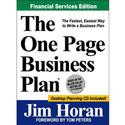Advisor Marketing Mindset and Ice Storms
 We live in the mountains of Southern Oregon about 7 miles north of our town, Grants Pass. There are generally 5 or 10 days a year when we wished we had 4 wheel drive.
We live in the mountains of Southern Oregon about 7 miles north of our town, Grants Pass. There are generally 5 or 10 days a year when we wished we had 4 wheel drive.
Friday night was one of them. Ice storms during the week had caused thousands of homes to be without power. We’d been among them.
I’d just returned from week long business trip and wanted to take the family out to a highly recommended movie: The Blind Side.
Despite some misgivings about the roads, we headed out and got there without a problem. The movie was a winner and definitely worth seeing now rather than waiting for it to hit the rental stores. All we had left was the drive home. Easier said than done.
My decisions and the icy roads combined to add over 12 hours to our ride home.
Let me tell you some of the marketing lessons from all of this.
When we were just 15 minutes from home, the back of our van started fishtailing and I had no traction.
The problem was “black ice” which is clear ice over black pavement. Hard to see. Very difficult to drive upon.
So I took the do-it-yourself approach and spent 30 minutes putting on snow chains. Problem solved? Not exactly.
You guys from Alaska, Maine, and Minnesota must be telling yourselves, “What was he thinking?”
Well, I was thinking it would help me reach my destination. Kind of like an investor doing his own retirement planning. He knows his goal, getting enough money to retire on, but choosing the wrong tool will doom his retirement.
In my case, choosing the wrong tool, snow chains, allowed me to go another 100 yards up the hill. Unfortunately, going down hill I had no way to steer the van and was fortunately to get to the side of the road without landing in the ditch.
Now it was time to call in the professionals. I called the roadside assistance company.
Sadly, all I could get was an automated message telling me that their agents were busy and that it would take at least 4 hours to get service to our area.
At the time we needed their help most, we couldn’t talk to a live human being. No, this wasn’t AAA, we’d switched a few years ago to a different company to save some money.
Marketing lesson #1: Cheaper isn’t always the deal it seems to be. Don’t be afraid to charge higher fees if you’re worth it.
Marketing lesson #2: Try to give your clients the ability to speak to a real human being. One of my advisor clients had a tradition of ALWAYS answering the telephone with a live person. No answering machines, no voice mail, no auto-attendant. When the office was closed (and at lunch time), their phone was answered by an answering service. The planner or someone on staff could be tracked down 24/7/365. Think about how this sets them apart.
At this point, we had 2 choices: walk six miles home over icy roads or 1 mile back to town and stay with friends.
Some of us saw this as an adventure and were clearly in shape enough to walk six miles in the dark at 12:30 at night. Others weren’t so sure.
This is when my “marketing mindset” kicked in.
I imagined the front page of our local paper. Worst case: “Family perishes trying to walk 6 miles through ice storm.” Better case: “Family suffers frostbite attempting nighttime 1/4 marathon over icy roads.”
Neither would reflect very good judgment on my part. My “marketing mindset” told me that going back to town was the way to go.
So we called our pastor at 12:30 and told his wife of our plight. We said we’d call back once we were in town because we didn’t want them to get stuck as well.
And at 1:30 a.m. we got picked up somewhat tired, cold and damp. Within minutes we got to their home for a few laughs and some hot tea.
The next day we were able to pick up our van and get home to our pets. I clocked the mileage and got a pleasant surprise:
The six of us actually walked 2.5 miles getting back to town…2.5 mph was a pretty good pace considering the conditions.
And we didn’t make the front page of the newspaper either. Trust me when I tell you of the necessity of developing a marketing mindset!
Finding More Time for Marketing – Part 3
 In “Finding More Time for Marketing – Part 2,” we looked at ways to cut your time spent on administrative activities. Now we’ll look at a few ways to free up time for marketing by cutting down time you spend on “Operations” which you know better as production activities.
In “Finding More Time for Marketing – Part 2,” we looked at ways to cut your time spent on administrative activities. Now we’ll look at a few ways to free up time for marketing by cutting down time you spend on “Operations” which you know better as production activities.
Becoming more efficient on the production side does two things for you:
- You free up time to spend on marketing related activities
- You free up time to handle more clients.
#2 is key because you (and your staff) must handle more clients in the same 8-hour day. Otherwise getting more clients robs time from marketing activities. When you neglect marketing, the well runs dry and you run out of prospects. Not good. Not fun either.
Whether your practice is large or just getting started, technology correctly used can quickly improve your operational efficiency. One hour saved per day means over 250 additional hours over a given year. Time better spent getting and serving clients.
Some time ago, I had a client with decades of experience, excellent credentials, and happy clients in more than a dozen states. Yet he was a technology newbie to the extreme.
When I emailed him some questions, his assistant would print out the email for him. He would handwrite his comments and give it back to his assistant. She would fax it to my office. My assistant would call me to let me know I had a fax. When I was away from my office, I’d have her scan it in and email it to me. Incredible!
Thankfully, he got a new computer and some training, and soon replied to my emails with another email. And he freed up his assistant for more productive tasks.
Yet don’t fall into the trap of adding technology just for technology’s sake.
A client of mine is a member of the 300 Financial Group which takes a “Goldie Locks” view of technology. Not too much technology, not too little…just the right amount. In 300 Financial’s view, technology should:
- Make you more money
- Save you time
- Provide the information that helps clients make better and quicker decisions
You can learn more about 300 Financial’s technology approach by clicking here.
Go Paperless
Going paperless helps you in many ways: less office space needed, more productive staff, and less time preparing for client meetings.
One advisor I know went paperless from the beginning of his practice and has instant access to all client communications. And very few file cabinets in his office.
I know another advisor in the same town which has a huge room filled with file cabinets. And support staff which spends many hours every day keeping track of the paperwork and getting everything filed properly.
Obviously newly established practices have the advantage here: no file cabinets holding decades of client records. Yet practices with tens of millions of assets under management gain the most from office automation because your support staff can become far more productive.
Depending on your situation, this may be an incredibly daunting task. Yet the longest journey is begun with the first step so read these articles on ways to get started.
No More Fax Machine
7 Ways to “Say it” and not “Type it”
Autopilot Computer Backup
Track your time and see where all the time goes. Decide how much time you need to devote to marketing your practice each week. Then get started on reducing time spent on administration and advising. You’ll free up time for marketing your practice and reap the rewards later.
Finding More Time for Marketing – Part 2
 When you are trying to free up time to spend on marketing activities, admin is a great place to look.
When you are trying to free up time to spend on marketing activities, admin is a great place to look.
Admin includes all the backoffice activities which support the marketing and advising activities of the firm. You have one or more employee; you need payroll. You have vendors; you need to pay bills. You make a profit; you need tax returns. You have dust balls in the reception area; you need to vacuum. What’s that? You have a janitor for that? Great.
The general rule is to outsource everything you can: receptionist to answer calls, bookkeeper to pay bills and prepare payroll, CPA to prepare taxes, janitor to clean the office, and so on.
You may or may not enjoy these tasks. You may or may not have the education and experience to do them well. The point is to increase time spent on marketing means you save time elsewhere. Just because administrative activities need to get done does not mean you have to do them yourself.
I know one advisor who prepares his own personal and business income tax returns. As his practice continues to grow, this has got to go. Spending 4 hours every quarter for estimated taxes and 2 days in March for business returns and 2 days in April for personal returns means 8 days per year are spent on administrative tasks. This time can be better spent advising clients or marketing his practice.
Here’s a rule of thumb to consider: Outsource any task which can be done for less than your billable rate. If you charge out at $175 per hour, then pay a CPA $100 per hour to prepare your tax returns.
What if you’re an independent advisor without any staff? Do you need to do it all for the time being. Not necessarily. You just need to be more creative.
Consider locating your practice in a professional business center. Executive suites offer professional receptionist and administrative services on an as-needed basis. You have access to conference rooms when you need them. You pay a monthly fee which includes your office, telephone, fax, internet, janitorial and security. You save time because someone else deals with these various administrative services. Many executive suites allow conference room and day-use office access in affiliated business centers.
One advisor in New Jersey offers to meet clients in various cities to make it more convenient for his clients. So he not only saves time and money on administrative activities, he gets a marketing boost to boot.
Another possibility would be co-locating your office with a CPA or attorney. You’d benefit in many of the same ways as moving into an executive suite. Plus you’d be available for referrals from the accountant or attorney and get visibility from their walk-in traffic.
Either option means you don’t need to fill the role of Office Manager and deal with all the administrative details of running an office. You also add a receptionist between you and your clients and prospects which makes your firm bigger than just you.
And every minute you cut from admin means another minute spent on marketing.
Finding More Time for Marketing – Part 1
 You want to grow your practice by increasing your focus on marketing activities. You know this will take time. Yet you feel overloaded these days already. Where can you find some more time?
You want to grow your practice by increasing your focus on marketing activities. You know this will take time. Yet you feel overloaded these days already. Where can you find some more time?
I remember a few years ago when my daughter was getting ready for her big sister’s high school graduation ceremony. Time was running short. She was getting stressed. Was it related to her hair or her outfit? I don’t remember. I do remember her crying out, “Time, time. I need more time!” Don’t you feel that way sometimes?
While you can’t create more hours in the day but you can change how you spend your time each day. How? Budgeting, of course!
The process for budgeting your time is the same for budgeting your money. You want to see how you’re spending your time now, set “time spending” goals, and then create a plan to reach your goals.
Let’s look at how time is spent in virtually every business…whether a one-man operation or Walmart.
Every business has 3 main activities: Marketing, Operations, and Administration.
Obviously, Walmart has entire divisions of people spending 100% of their time on some aspect of one of these 3 areas. Yet the CEO must oversee all 3 areas and ensure none is neglected. At the store level, the store manager has a few people in marketing, many in operations, and some in admin to do payroll, keep the lights on, and pay the rent.
How does this activity breakdown look like for financial advisors?
- Marketing attracts and gains new clients
- Operations takes care of clients, and
- Admin includes back office work such as office management and compliance.
Based on conversations with many financial advisors, the general consensus is that “marketing is what I need to do, planning is what I like to do, and admin is what I hate to do but must do to keep out of trouble.”
So when time is tight which area gets neglected? Yes, marketing.
Now take a look at your calendar and see how you spend your time in marketing, operations and admin. Does your calendar only show time spent with prospects and clients?
In this case, you need to start tracking time spent on marketing and admin. You might be shocked at what you see. Or don’t see.
Just don’t be discouraged. Your business might be doing okay and you’re spending only a couple hours per week on marketing. Imagine if you started spending 30-40% of your time on marketing?
You’ll find it helpful to separate marketing into its two main functions: sales and marketing. What’s the difference?
Think of marketing as “leading the horse to water” and sales as “making him drink.”
Marketing is all about attracting new prospects as well as getting your existing clients to buy more and more often. You do this with your website, printed and e-mail newsletters, public seminars, advertising and all other ways of getting the word out. This also includes making it easy for your clients to refer their friends and relatives.
Sales is persuading that prospect in your office or conference room to place their trust (and money) with you.
Sales & marketing efforts work together to grow your practice. For example, any advisor without any marketing materials, advertising, or website has a much tougher job convincing the prospect in his office to become a client. Why? Because targeted marketing efforts attract more qualified prospects while screening out others. And marketing materials help tell your story well before your prospect walks in the door.
So your action item is to track your time in Sales/marketing, operations, and admin. In my next article, I’ll take a closer look at admin.
“The One Page Business Plan” for Financial Advisors
“The Cobbler’s son has no shoes.” ~anonymous
 This famous quote speaks about the successful Cobbler makes shoes for everyone in the village except his own children. Sound like anyone you know? Perhaps the CPA files hundreds of tax returns by April 15th but never his own. Or the Gardener who forgets to water his lawn in the middle of summer.
This famous quote speaks about the successful Cobbler makes shoes for everyone in the village except his own children. Sound like anyone you know? Perhaps the CPA files hundreds of tax returns by April 15th but never his own. Or the Gardener who forgets to water his lawn in the middle of summer.
Many advisors prepare retirement plans, estate plans, and business succession plans for others yet never sit down and prepare a business plan for their own practice. Sound like you?
Business plans traditionally took many hours to prepare, filled thick binders with pages and pages of market data, product and service plans, and financial forecasts. A business plan’s chief purpose was to get a bank or investor financing and was soon forgotten. Especially after the five figure consulting fee was paid. Was it used to run the business? You must be joking!
No wonder few businesses, including planning practices, prepare a plan and execute it to reach financial and practice goals. The cost in time, trouble, and money just wasn’t worth the perceived benefit.
Jim Horan’s series of books entitled, The One Page Business Plan has changed this gloomy picture for over 250,000 businesses since 1994. Now you can create a one page business plan to help define your practice, set goals, and define activities to help you reach your goals. In 2008, he wrote a Financial Services Edition which makes your job even easier.
The book walks you through a series of thought-provoking self-assessments and fill-in-the-blank templates to help you do the following:
- Describe the vision for your practice in one compelling sentence.
- Define who you are in service of and what you will do for them in 8 words or less.
- Define success so that it is measurable, graphable and achievable.
- Develop a set of focused strategies that will guide the development of your practice over the next 3 to 5 years.
- Define and prioritize the critical practice building projects and programs that must be implemented to execute your strategies.
Does this sound like a lot of work? Well, the book provides lots of examples to borrow from and a proven methodology. You also get a CD with Excel and Word documents to help you through the process. All very helpful.
But can you really do this by yourself? Yes and no. You can certainly do it yourself and by yourself. You’ll be miles ahead of where you are now without any business plan at all.
I recommend working with trusted advisors such as your partners, business coach and even your spouse. These “extra eye balls” will help you see your firm where it really is today and keep you from setting unattainable goals.
The value of this book far surpasses it’s list price of $34.95. Or its discount price at Amazon.com of $25.21.
Have I used the book? Yes, I created a one-page business plan for my living trust seminar business. That’s how I discovered the book because I needed a business plan for an attorney and I needed it fast. I’ll use the non-profit edition to help craft a business plan for our local Gospel Rescue Mission on whose board I serve. Another situation where I can’t create a lot of extra work for the executive director.
I’ll help my marketing consulting clients create one page business plans for their practices before I touch their websites or fix their yellow page ads. Or do anything else.
You won’t go wrong with this book. Get it, read it, and put it to use!
Magic Bullet Marketing?
 You’re an independent financial advisor. You want to expand your practice. Should you get going today and “just do it”?
You’re an independent financial advisor. You want to expand your practice. Should you get going today and “just do it”?
For most advisors, the answer is “No.” Why is this?
Because you’ll probably end up wasting time and money and the effort will not succeed. Ouch.
I tell my clients that there is no magic marketing bullet which can easily and instantly expand your practice. I tell this to prospects because I don’t want a client with unrealistic expectations. Do you?
Imagine “Bob” calls your office for an initial consult. After introductions, you ask him what he wants you to do for him. Bob says with a straight face, “I lost 40% of my retirement portfolio when the market tanked. My current advisor pulled it out at the bottom so I missed the bounce. I want you to make up my losses in the next year. Can you do it?”
He throws his quarterly statement on your desk and you notice he has a million dollars in his account. Nice.
Time to bring Bob back down to earth, “Do you realize that making up a 40% drop in one year would require earning 67% on your money?”
Bob looks shocked. “I don’t want to take on that kind of risk at my age. What are my options?”
You explain how some combination of more time and more money can get his retirement portfolio back where it was. “You can increase your monthly contributions to the max and stretch out your time horizon to 5 years. This eliminates the need to use risky investments so you’re much more likely to reach your goal.”
Bob likes the sound of this and you land the account. Congratulations!
Now what does this story have to do with growing your practice?
If Bob had pressed you a bit, you might tell him there are no magic bullet investments that give high returns quickly with low risk. The same thing is true in the marketing world. With one important difference.
Making such bold promises as a financial advisor can land you in an arbitration hearing. Making bold promises as an ad rep helps land the account and make the sale. Ever hear of a newspaper giving a refund when no one attends your open house? Me neither.
Magic Bullet Marketing activities can include:
- Running an untested full-page ad in a new glossy seniors magazine
- Getting a larger yellow page ad. Or a yellow page ad in the new yellow pages in town.
- Creating a high glitz, beautiful, Flash-based website which gets no traffic and is instantly static
Almost any unproven, untested marketing activity done in haste qualifies as a magic bullet marketing activity. Or anything requiring “just a few minutes of your time and your major credit card….”
So the moral to the story is that expanding your practice takes time and money.
You can save time by hiring someone to help you get it done. Or you can invest your time and do it yourself when money’s tight.
I’d love to hear your comments on ‘magic bullet marketing’ efforts. Did you hit your target? Or fire a blank?
Developing Your “Marketing Mindset”
If you ran into an old buddy at your high school reunion, you’d probably be asked, “So what do you do?”
As an independent financial advisor, you have several ways to answer the question. What comes to mind first?
“I am a certified financial planner.” Or “I am a financial advisor.”
If he was curious to learn more, you might describe your approach to financial planning, estate planning, or risk analysis. You might talk about the financial markets, indexed annuities, or CD rates. You might mention the value of annual reviews and portfolio re-balancing.
This answer focuses on the main operational focus of your firm. It touches on your education, experience and what’s on your business card.
Yet in a big way you’d be wrong!
While you might really rather focus on planning all day long and every day of the week, the reality is that you need to see yourself as a “Marketeer.”
Just what is a “Marketeer”?
A “Marketeer” focuses on defining, reaching and serving his target market. This is job #1.
A Marketeer sees every aspect of his business as a way to enhance (or detract) from defining, reach and serving his targeted market. What does this look like?
- Whenever he meets someone new, he wonders how he might help him reach his financial goals.
- When the telephone rings, it’s not a bother but a chance to speak with someone who discovered his website and wants to learn more.
- Every client interaction is an opportunity to earn (or lose) future referrals.
- Marketing, like breathing, is done all the time…not just when the appointment book is getting slim.
- Hiring a new receptionist is a BIG deal.
Think the last bullet is a joke? Let’s take a closer look at this one.
If you only get one chance to make a good first impression, your receptionist will likely be the person to make it.
Will your clients care if she knows the ins and outs of six major phone systems? Or types 100 words a minute? Or has a degree in business from your local community college?
 None of this matters if your receptionist greets your office visitors with a frown or a grunt.
None of this matters if your receptionist greets your office visitors with a frown or a grunt.
If your receptionist has to “turn on the charm” because her default position is “strictly business” you have a problem in the making.
Your receptionist ought to care enough about people to chit chat while the client waits. Perhaps offers some coffee, tea or water upon their arrival. Ideally she knows what they like to drink and gets it without asking.
This does several things for you:
- You learn more about your clients lives and what’s driving them that day.
- You gain a bit of slack if you’re behind schedule and you can’t start the meeting on time.
- People like doing business with people they like and your receptionist has made YOU more likeable.
Of course knowing your phone system inside and out can help your receptionist better connect you to your clients. And typing 100 words per minute can keep your files up to date. And a business degree might bring new ideas into your practice and enhance customer service.
Yet do these things really matter if your receptionist greets visitors with a frown for a split second before the smile kicks in? Or makes callers wish you had a direct dial number so they didn’t need to “bother” the receptionist when they had a question?
In short, your marketing mindset causes you to hire the right person for every job, train them to know what’s really important (treating people kindly and with respect), and the all-importance of supporting the marketing vision of the firm.
When you develop a marketing mindset, you’ll view every aspect of your firm from the eyes of an A-List client. You’ll see many areas to improve:
- Is your reception area clean and inviting? Or does it look like a receiving dock?
- What do your clients see as they walk from your reception area to your office or conference room? A kitchen with a sink full of dirty dishes?
- Does your desk make you appear disorganized, overwhelmed, and out of control?
- Does your website look the same as when you got it back in 2002? Do clients or prospects have any need to come back a 2nd time?
- Do you use a Yahoo email account to correspond with clients?
- Do your clients only hear from you when it’s time for their annual review? Or worse, do you only speak with them when they call you with a problem?
- Do you spend time doing administrative tasks which could be delegated or outsourced?
- Do you use your planning abilities to create and follow a Marketing Calendar?
I think you get the idea. A marketing mindset, once developed, can liberate you from the administrivia which drains time and energy and keeps you from growing your practice and turning your clients into raving fans.
Yes, your business card should say “Certified Financial Planner Professional” or “Financial Consultant” or “Financial Advisor.”
Be sure to give one to your friend at your high school reunion.
But tell him, you “help baby boomers plan for and enjoy a prosperous retirement” or however you benefit your targeted clientele.
